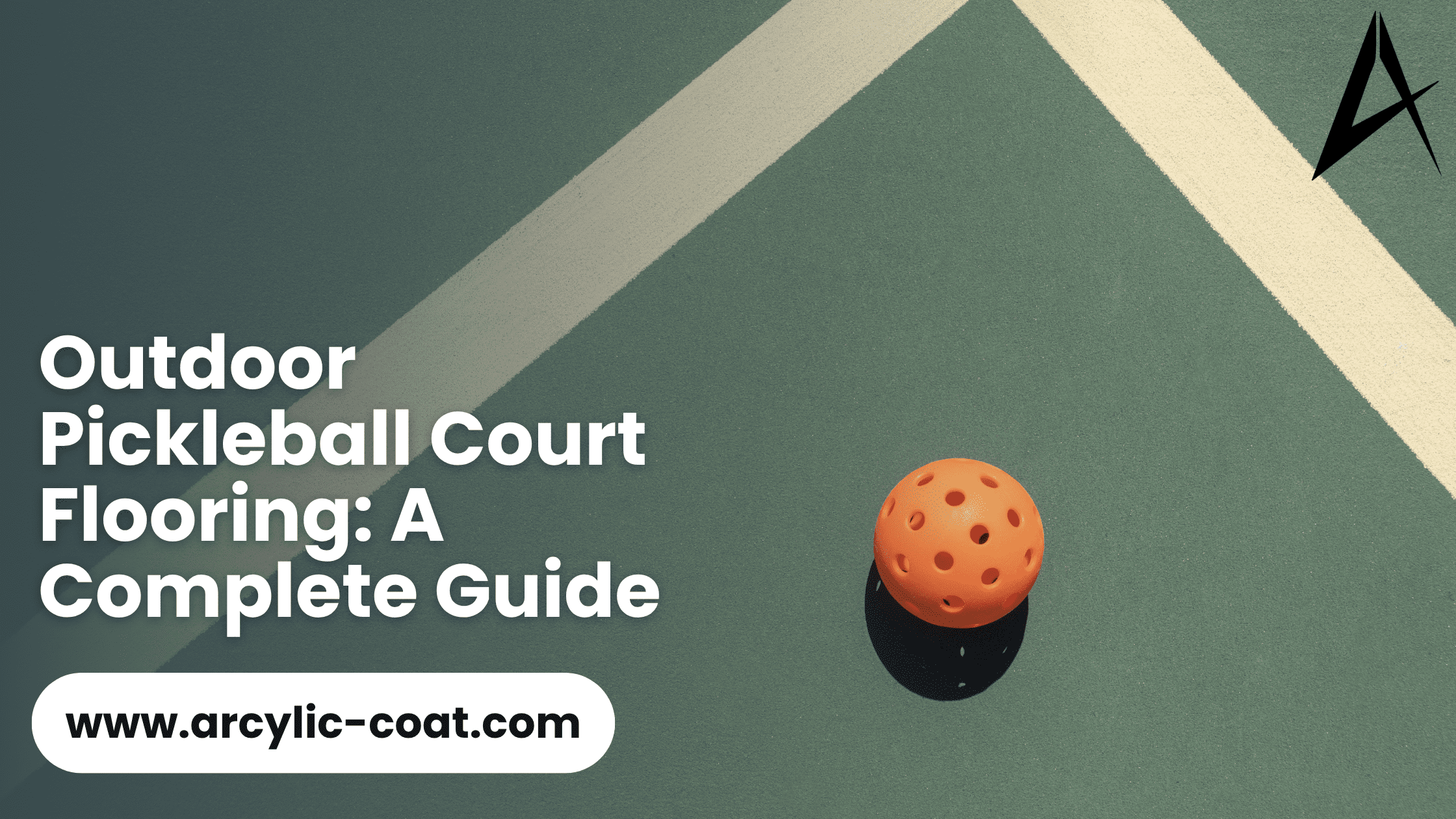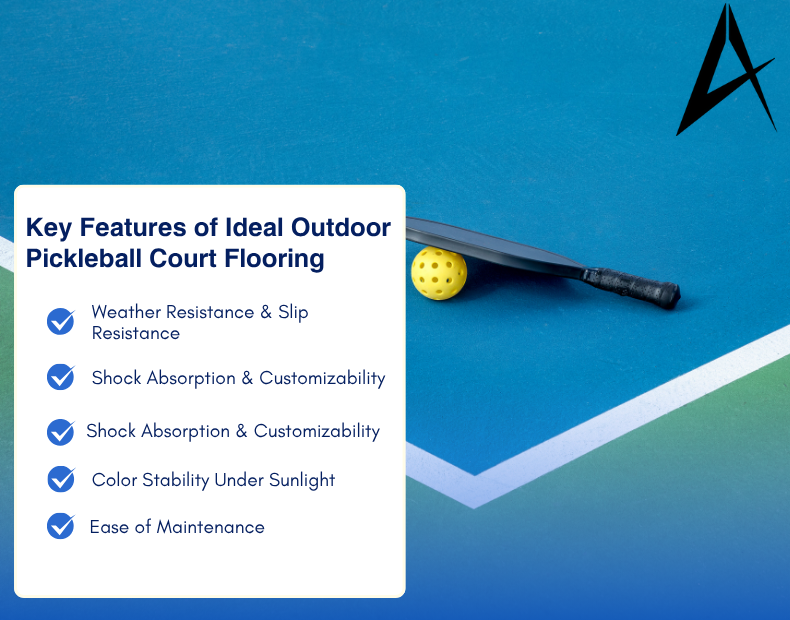
Pickleball is quickly becoming one of the most popular sports in the world, a combination of tennis, badminton and ping-pong. Its accessibility and fast pace appeal to players of all ages and skill levels. As demand for dedicated courts grows in parks, clubs, schools and residential communities, the importance of Outdoor Pickleball Court Flooring has never been greater. The surface you choose directly impacts the safety, game performance, durability and long-term maintenance.
Read our expert guide to pickleball court construction and synthetic acrylic sports flooring and find out why choosing the right materials is key for outdoor play. From weather-resistant flooring and standard court dimensions to installation techniques and future surface technology trends, this complete guide has it all. Whether you’re building a new court or upgrading an existing one, making informed decisions will mean better playability and longer surface life.
Understanding Pickleball Court Requirements
Before we get into the different types of Pickleball Court Flooring, let’s cover the basics of the court layout and specs. A standard Pickleball court is 20 feet wide by 44 feet long and can be used for singles or doubles. The court is divided into several areas, including baselines, sidelines, service boxes and the non-volley zone (aka the “kitchen”), which is 7 feet from the net on both sides. These lines are crucial to the game, defining movement zones and serving rules.
Learn about Pickleball court construction, synthetic acrylic sports court flooring and how different surfaces affect player performance. Quality flooring gives better ball bounce and consistent traction and reduces the risk of injury. The choice of material also affects court durability, maintenance and resistance to outdoor elements like rain and UV. Whether you’re building a court for recreational or competitive play, knowing these basics will give you a court that meets the official standards and is fun and safe for everyone.
What Makes Outdoor Pickleball Court Flooring Different?
When considering indoor versus outdoor pickleball court surfaces, there are a number of important factors that are involved—particularly in planning for long-term usage and safety.
- One of the biggest issues with outdoor courts is weather exposure. They must survive rain, temperature fluctuations, humidity and infrequent flooding. The materials must be resistant to water damage, warping and erosion in order to be able to keep the surface playable.
- UV radiation is also a major consideration. Outdoor courts are exposed to direct sunlight every day, which can weather traditional indoor surfaces, causing them to degrade, crack or become brittle. So UV-resistant coatings are essential for maintaining color stability and surface integrity over a period of time.
- Traction and durability also matter. Rougher, textured finishes are required on outdoor courts to avoid slipping in wet or dusty weather—whereas fast, grippy indoor finishes are achieved with smoother surfaces.
Deployment of indoor-grade floor materials outside can cause early wear, increased maintenance and safety concerns. That is why outdoor court surface materials are specially formulated with advanced technology to handle weather, perform and deliver a consistent playing surface under all conditions.
Top Materials Used for Outdoor Pickleball Court Flooring
Selecting the proper Pickleball Court Surface Materials equates to performance, durability and minimal maintenance. These are the most sought-after outdoor options:
Acrylic Sports Flooring
One of the most popular options for outdoor pickleball courts, synthetic acrylic floor materials are made to endure severe weather, UV degradation and long-term performance. Spread over asphalt or concrete, acrylic toppings provide a smooth textured surface for even ball bounce and great traction. The reflective, custom colors enhance the appearance and visibility of players.
- Affordable and environmentally friendly
- Easy to install and replace
- Long-lasting and durable
Why Synthetic Acrylic Flooring is the best choice for outdoor pickleball court flooring: It’s the optimal combination of durability, comfort and pro-level looks—ideal for both recreational and competitive applications.
Modular Tile Systems
These snap-together plastic tiles are a favorite for Pickleball Court Flooring when fast installation or mobility is the requirement.
- Easy to install and replace
- Drainage channels for rainwater
- Good grip and cushion underfoot
Although modular tile systems lack the smooth finish of acrylic coatings, they’re ideal for temporary or multi-purpose use. They can be disassembled or relocated with ease without having to harm the court base.
Cushioned Coatings
A special type of acrylic system with built-in layers to absorb shock and reduce impact on joints. Great for senior players, high-traffic courts or courts focused on injury prevention and player comfort. The cushioned underlayer feels softer underfoot without sacrificing ball bounce or traction—a smart upgrade for long-term playability.
Asphalt or Concrete with Acrylic Coating
Asphalt and cement are considered the best surfaces for pickleball because of their strength, stability and affordability. When paired with a high-quality acrylic coating, these hard surfaces become smooth, game-ready courts with reliable ball bounce, weather resistance and slip protection. The acrylic layer also allows for color customization and clear pickleball court markings. It is the most popular choice for permanent outdoor courts because of its durability, low maintenance and professional-level performance in all weather conditions.
Key Features of Ideal Outdoor Pickleball Court Flooring

Great Outdoor Pickleball Court Flooring must be designed to withstand the outdoor elements while keeping players safe and comfortable.
- Weather Resistance is key so the surface can handle rain, UV and temperature changes without cracking or warping.
- Slip Resistance prevents falls during fast games, especially in wet or dusty conditions.
- Shock Absorption reduces joint stress and fatigue, so the court is more comfortable for long play.
- Color Stability Under Sunlight keeps court markings and colors looking vibrant and visible over time, even under harsh UV rays.
- Ease of Maintenance keeps the court looking and playing like new with minimal effort—perfect for public parks and high-use facilities.
- Customizability allows for personalized court design, including colors, surface textures and precise pickleball court lines.
All of these features mean long-term durability, fewer repairs and a safe and enjoyable playing experience—so they’re a must for any well-built outdoor court.
Standard Pickleball Court Size and Markings
Pickleball court dimensions and lines are key to fair play and USA Pickleball standards. A standard outdoor pickleball court is 20 feet wide by 44 feet long and can accommodate singles and doubles play.
One of the most important areas is the non-volley zone, also known as the “kitchen,” which is 7 feet from the net on both sides. Players can’t volley in this area for safety and fairness.
The court is divided into service areas by a centerline on each side where players must serve and receive. All boundary and service lines are 2 inches wide and white or a contrasting color to be visible against the court surface.
Synthetic acrylic flooring is a great base for these lines, as the surface allows for sharp, durable lines that can withstand weather, UV and heavy use. This means court lines will stay clear and visible over time and a professional and safe playing environment.
Maintenance Tips for Long-Lasting Performance
Even with durable materials, Pickleball Court Maintenance is key to long-term performance and safety:
- Ongoing Cleaning: Keep the court surface clear of dirt, leaves and debris to avoid surface damage and slipping hazards.
- Inspection: Check for cracks, water accumulation, fading or other wear and tear that may affect play or safety.
- Touch-Ups: Recoat acrylic coatings or repaint court lines as needed to keep markings clear and the surface durable.
- Seasonal Inspections: Make sure drainage systems are working to prevent water buildup and keep the court surface intact during weather changes.
Following a schedule not only extends the life of the court but also gives you a safe and enjoyable playing experience. Maintenance prevents costly repairs and keeps your outdoor pickleball court flooring in top shape all year round.
Choosing the Right Manufacturer or Supplier
The durability and performance of a pickleball court rely on the quality of the installation team as well as the materials used. In deciding to select Pickleball Court Builders, consider these important points:
- Experience: Select builders with extensive sports flooring installation experience, particularly outdoor pickleball courts. Experienced individuals understand the nuances of surface preparation, coating application, and drainage for an optimal performance court.
- Product Quality: Use materials with higher UV resistance and durability that are certified for use as outdoor sports surfaces. High-quality synthetic acrylic flooring material maintains color and surface integrity even in harsh weather.
- Warranty and Support: Trustworthy builders provide full warranties and regular support so that your investment is secure and problems are resolved promptly.
- Customization Features: Search for companies that provide custom court designs, color options, surface finishes and correct pickleball court lines to suit your requirements.
With a reliable supplier such as AAL, you have access to high-quality synthetic acrylic floor covering products and technical advice to obtain a performing, durable and good-looking court.
Future Trends in Pickleball Court Flooring
As pickleball continues to grow in popularity, innovations in outdoor pickleball court flooring are changing the way courts are designed and used. One of the biggest trends is eco-friendly materials—sustainable, recyclable flooring that reduces environmental impact without sacrificing performance or durability. These green solutions are for communities that want to build responsible and long-lasting sports facilities.
Another cool trend is smart court features where integrated sensors and technology track player movement and shot accuracy and give real-time coaching feedback. It makes for a more interactive and fun playing experience for all levels of players.
Multisport flooring is becoming popular, with courts that can be converted for pickleball, tennis, basketball and other sports. It maximizes space and investment for facilities. By staying ahead of the flooring trends, facilities can have modern, competitive and sustainable courts for years to come.
High-Performance Sports flooring Solution: Built for Grip and Game Flow
| Tennis Court Flooring | Volleyball Court Flooring | Badminton Court Flooring |
| Basketball Court Flooring | Walking Track Flooring | Multi-Purpose Court Flooring |
Conclusion
The right outdoor pickleball court flooring is a balance of performance, safety and durability. Whether you are building a residential court, club facility or public sports complex, choosing high-quality material like synthetic acrylic flooring is key to long-term success and low maintenance.
Read our expert guide on pickleball court construction and synthetic acrylic sports flooring to make informed decisions for your space. For expert solutions and qaulity material, AAL—a leading name in sports court flooring and Pickleball Court Installation in India. With years of experience and commitment to quality, AAL ensures every court meets the highest standards of performance and durability.
Frequently Asked Questions
The standard pickleball court dimension is 20 feet x 44 feet with a 7-foot non-volley zone (kitchen) on both sides of the net.
₹3 lakh to ₹8 lakh in India, depending on surface material, site preparation, court size and labor charges.
No, tennis can’t be played on a pickleball court due to size difference. But pickleball can be played on a tennis court with proper markings.
Up to 4 pickleball courts can fit on a tennis court when placed crosswise with proper markings and spacing between courts.
Apply pickleball court lines, use portable nets and optionally resurface with synthetic acrylic for better grip, visibility and multi-use performance.
